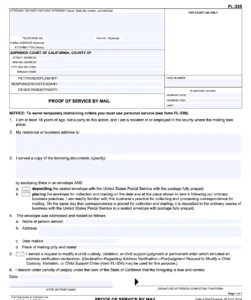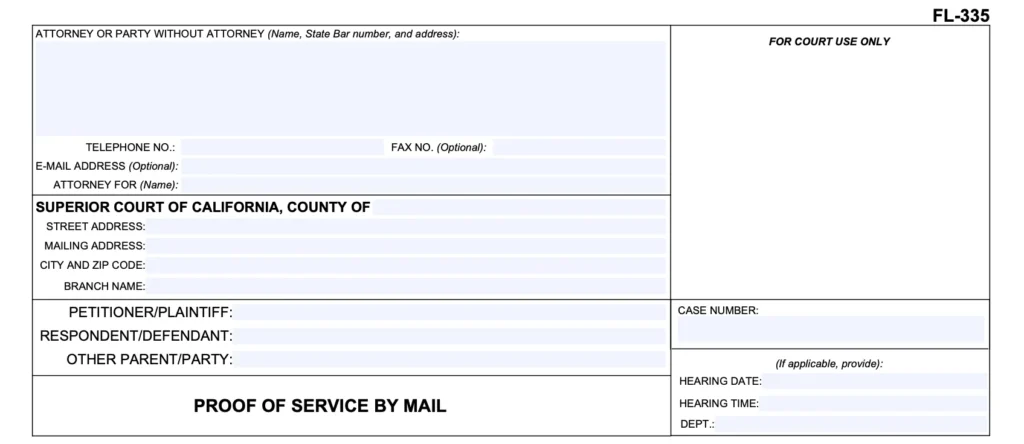Get California Online Divorce Forms for $299 – Limited Time Offer!
Read our blogs to get tips on California uncontested, online, and DIY divorce.


Share

Share
What if the entire California divorce process is stalled by a simple mailing error? The FL-335 Proof of Service by Mail form is your official proof that you served your spouse properly by mail, unlike the FL-330 (proof of service personal service).
This guide will take you through how to fill out the FL-335 perfectly. For your complete peace of mind, The Complete Divorce – California’s premier online divorce and legal separation program.
We can help you fill out the forms, review your and your spouse court forms, and file for you, so your divorce remains error free and you complete the divorce as early as possible.
Check if you’re eligible for California divorce? The Complete Divorce gives a free trial (with no credit card information required). The Complete Divorce to verify if you are eligible for a divorce!
The FL-335 is a court form that you must file to show that you mailed divorce papers to your spouse. You can get the FL-335 from the California Courts web page (as you can with most court forms), but we made our alternative version easier to use.
It is important to correctly fill out an FL-335 because the court cannot proceed with your case without this proof. You must file this form within 60 days after you served the divorce papers to your spouse.
The key difference between the FL-330 and the FL-335 is the manner in which documents are served and when they are used in the process in California divorce. Both the FL-330 and FL-335 can be used to serve the same forms.
Used when a person over 18 years old (not a party to the case) physically delivers the documents to the recipient. This may be used to show service of the Response to Dissolution of Marriage (FL-120) , or for any other documents that are filed during the process.
The FL-335 (Proof of Service by Mail) is used when the documents are mailed to the other party after the case has been filed. This form can also be used to serve the Response to Dissolution of Marriage (FL-120). This form cannot be used to serve the Petition for Dissolution of Marriage (FL-100). .
For the Petition documents (FL-100, FL-110, and FL-105), these cannot be served using the FL-330 or the FL-335, and must either be personally served using Personal Service, FL-115 or served via mail using the FL-115 plus specialized form of Mail with Acknowledgement of Receipt (FL-117).
If following this section feels too tricky, you can get a Fully Guided DIY Divorce. This helps you tackle all forms and makes ending your marriage simpler and less expensive.
In this section, we will walk you, the server, through each part of the form, including your own information, the recipient’s information, what court documents you served, method of mailing, and the final declaration.
With The Complete Divorce, our guided platform makes completing and editing your FL-335 seamless and error free.
This part identifies your case to the court clerk. It is very important to get this right to be sure that you complete and file your form in the correct case.

Here identifies the person filling out the form. If you have an attorney, they will write their State Bar number, address, and your name as their client.
If you are representing yourself, check the box for “Party Without Attorney,” then write your name, address, phone number, and indicate whether you are the petitioner or respondent.
This part sends your form to the courthouse that is handling your divorce. When completing this section, be sure to write out the complete name of the Superior Court county, such as “County of Los Angeles.”
Then, under that, provide the complete street address, mailing address, city, zip code, and branch name if any. You can find this information on your first paperwork or on the court’s website.
This section is to identify the people involved in the divorce case. Therefore, write the full legal names of the two spouses as they are written on the Petition (FL-100), identifying the Petitioner as the spouse filing and the Respondent as the spouse responding; the “Other Party/Parent” field will seldom be needed and is usually left blank.
The purpose is to connect this form to your specific divorce and an upcoming court hearing date, if one exists.
You will need to include the case number that you received when you first filed your divorce petition, which is stamped on your initial forms; fill out the hearing date, time, and department if you are serving papers for a scheduled court hearing, and leave blanks for initial filings.
This portion is an affidavit from the person who mailed the documents (the “server”) acknowledging that they are legally allowed to carry out this function.

You will see, “I am at least 18 years of age, not a party to this action, and I am a resident of or employed in the county where the mailing took place.”
This means that the server must live in or work in the same county as the county from which the documents were mailed.
For example, if the documents were mailed from Orange County, the server must live or work in Orange County. However, the server does not need to live or work in the same county as the court action.
Immediately after the statement, you should see a box, “My residence or business address is:” In this box, the server must provide their complete, current residential address or business address.
This allows the court to accurately have contact information for the server. If the server uses their employment to fulfill the county requirement, they should enter their business address here.
This section requires you to provide a detailed list of the documents sent to the other party. Here’s how to fill it correctly:

This part gives important facts of the mailing: who is the receiver, where was it sent and when was it sent.

The checkbox only applies in limited situations.
You only check this box if you are serving the paperwork to modify a current court order regarding child custody, visitation, or support.
You are requesting the modification after the judgment, and so you must have undergone the divorce or separation process. You do not check this box after serving the initial divorce papers.
Checking this box provides confirmation that you also served a special additional form called the Declaration Regarding Address Verification (Form FL-334).
This form confirms that the court has the parents’ most current address so that the children can be protected. If your request is not to modify any child-related order, be sure to leave this box blank.
This is the most important part of the form; the server is making a sworn statement to the court.

The last step makes this document legally valid:
Learning how to navigate court forms by yourself is a challenging task, but you have other options. The Complete Divorce plan allows you to receive guidance from Divorce Financial analysts and paralegals complete with all of the paperwork free from a lawyer.
This is one way to get a cheap divorce without a lawyer while leaving you with no worries over errors in your documents. Here are a few tips to help you avoid mistakes:
We will take care of the details. Find out if you qualify and start your FL-335 for free at The Complete Divorce.
You receive it after you properly fill out a Proof of Service form, like the FL-335. The person who mailed the documents will sign it under penalty of perjury. You will file that form with the Court as a record of service.
It is a completed FL-335 form. It is your sworn statement that you served documents via certified mail. You must include the certified mail tracking number on the form, or on a separate attached declaration for proof of mailing.
The initial divorce papers must be served to your spouse within 60 days after your case is filed; however, you have an overall period of 90 days from the time you file to have the Proof of Service filed with the court.
The initial documents to be served are the Summons (FL-110) and Petition (FL-100). Every other motion or legal document you file during the case also needs to be served, so the other party is formally notified.
Form FL-335 is a typical proof of service, which is the Proof of Service by Mail form in California courts. It contains the information of the server, recipient, documents that were sent, and how they were sent, all verified by a signature under penalty of perjury.

I’m Dina Haddad, a family law attorney-mediator in California. I’m so tired of couples not having a process that’s easy to complete their divorce. They are getting lost, wasting time and money, and beyond frustrated with their results.That’s why I created TheCompleteDivorce. I took my successful mediation practice and condensed it into an affordable and winning program.